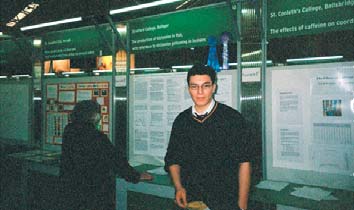| 2005 |

|
YEAR BOOK |
Stratford College, Rathgar, Dublin 6
|
Studies on the production of histamine in fish, with special reference to histamine poisoning in humans
|
In January 2005 I entered a project for the Esat BT Young Scientist & Technology Competition on the topic of Histamine Poisoning. Histamine food poisoning is a food�borne chemical intoxication caused by the ingestion of fish containing unusually high levels of histamine. Fish from the family Scombridae, particularly mackerel and tuna, contain high free levels of histidine in their flesh and are most commonly implicated. Histamine is formed when bacteria produce decarboxylase, which acts on free histidine in the fish muscle. Fish spoilage by biogenic amine production is enhanced by improper preservation and inadequate refrigeration with the optimal temperature for histamine production being 25�C. Once a bacterial population has been established, enzyme activity continues even when refrigeration temperatures are applied, although bacterial growth stops. A sharp metallic, bitter or peppery taste and a honeycombed appearance may be present in the fish.
Studies were carried out to demonstrate the conversion of histidine to histamine by High Performance Liquid Chromatography (HPLC), using the enzyme histidine decarboxylase. Histamine is a toxic biogenic amine derived from the natural amino acid histidine. It causes dilation of blood vessels and contraction of smooth muscle (e.g. lungs). It is released in large amounts after skin damage. Histamine is also released in anaphylactic reactions and allergic conditions.
A standard curve was set up for histidine and histamine. By using a Linear Regression Programme unknown amounts of histidine were calculated. Using the enzyme assay for histidine conversion, samples were analysed at different time points. The histidine reduced rapidly in the absence of citrus bioflavanoid while in the presence of bioflavanoid, it reduced more slowly. This suggested that the enzyme was inhibited by citrus bioflavanoid. Using the same enzyme assay for histamine conversion, samples were analysed at different time points. The histamine did not increase as rapidly in the presence of bioflavanoid. This again suggested that citrus bioflavanoid inhibited the enzyme.
Mackerel was then incubated in the presence and absence of citrus bioflavanoid. Samples were analysed at different time points up to 3 days. The histamine did not increase as rapidly in the presence of bioflavanoid. This again suggested that bioflavanoid inhibited the enzyme histidine becarboxylase.
The results demonstrated that bioflavanoid inhibit histidine decarboxylase. Previous work has shown that bioflavanoid also kill bacteria. Thus, this project would suggest that dipping fish (especially Scombroids e.g. tuna and mackerel) would help to prevent spoilage by reducing the production of histamine.
I am very grateful to Dr Jack Bloomfield of the Chemical Analysis Laboratory (CAL Ltd) for his assistance and interest, and also to Mr Brendan Chambers of BioNatural Solutions Ltd for his support.

| This article was sponsored by the Marine Institute |
|---|